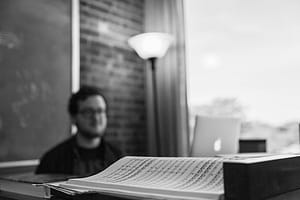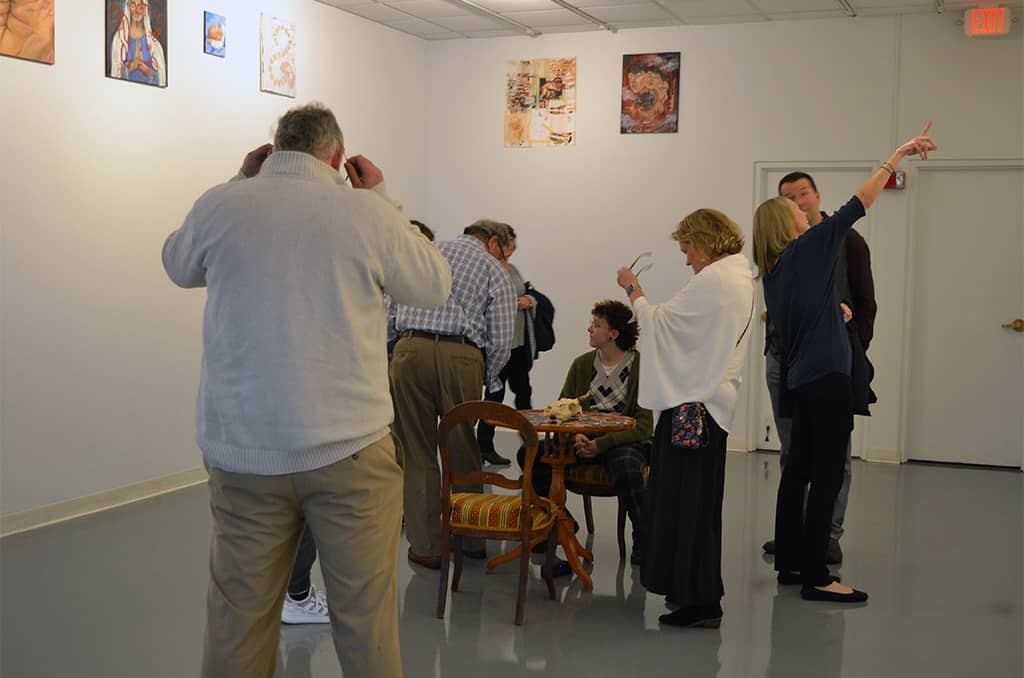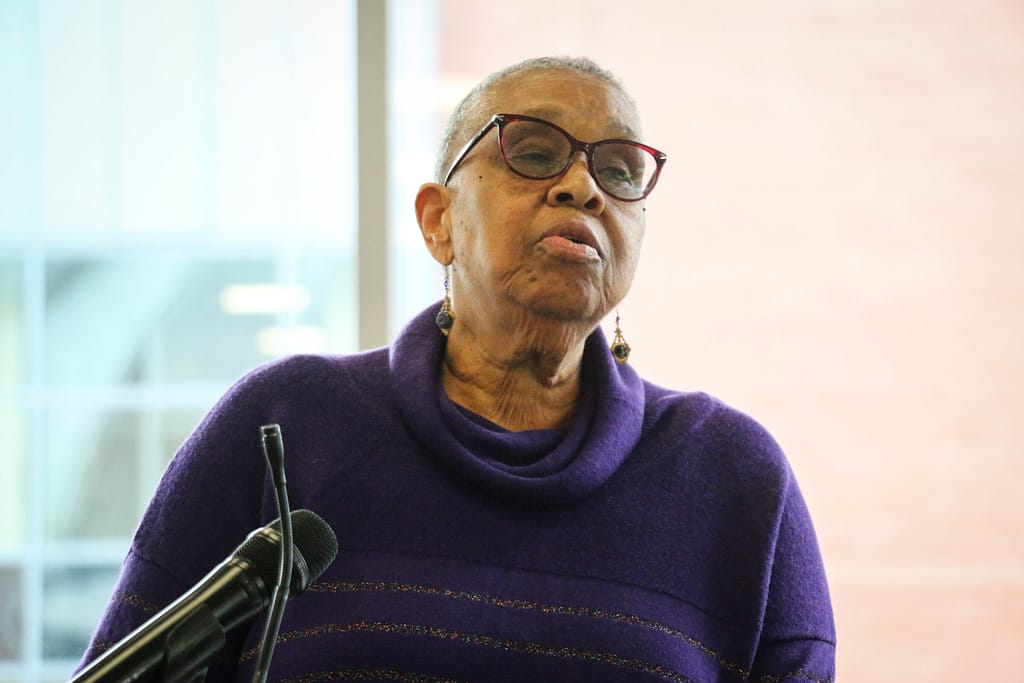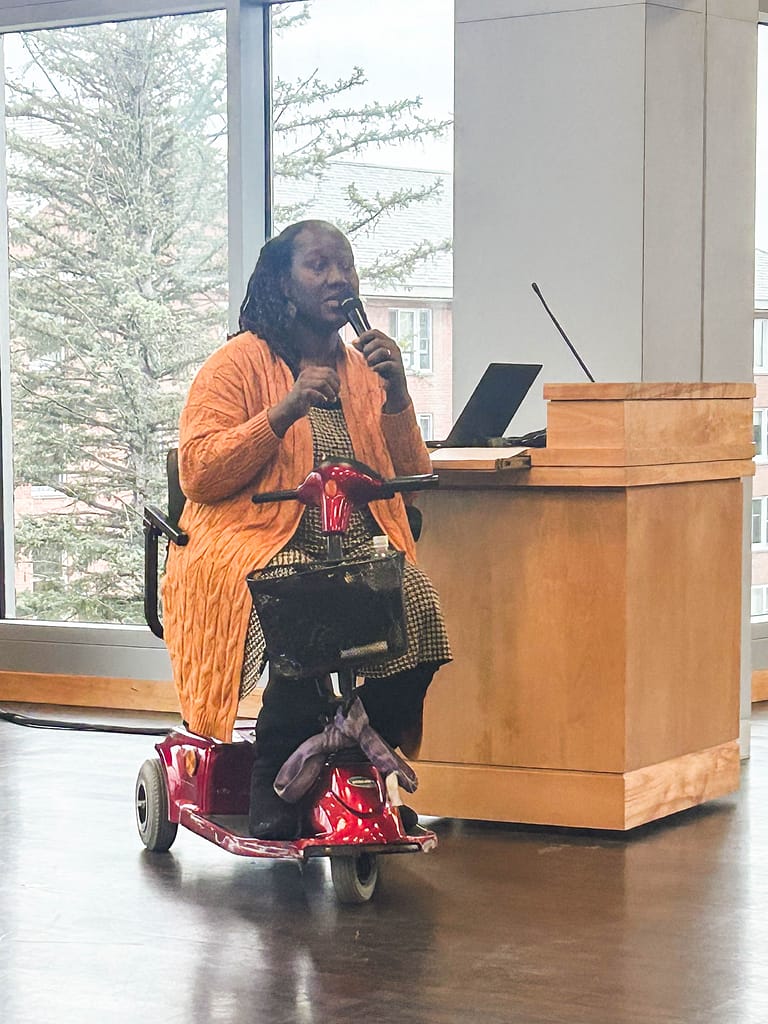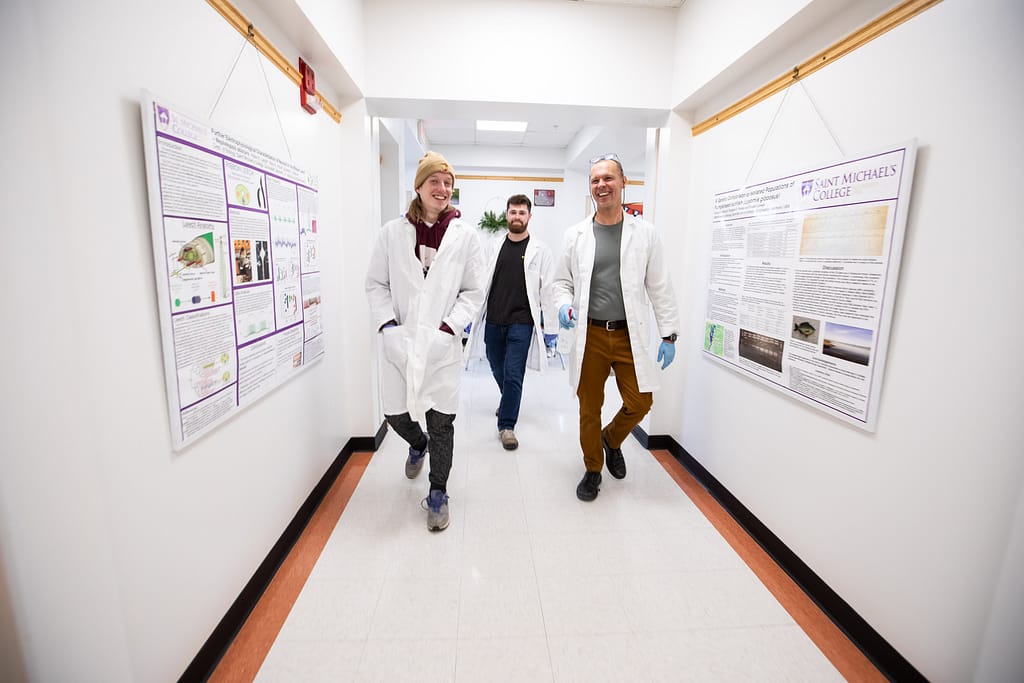New project merges music, psychology
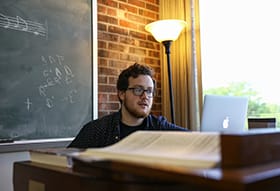
The photos above show Conor Macias in his McCarthy Arts Center practice room as musical scores are laid out in the foreground atop the room’s piano. Other images below capture Conor from other perspectives during his work as a student-composer. (Photos by Ethan Simmons)
Conor Macias ’19 describes the moment “the lightbulb went on” for him regarding an interesting and substantial summer research project idea to merge his majors in music and psychology.
“I had just finished up my research methods class in psychology the semester prior when I saw a flyer about a meeting on summer research,” recalls Macias, who is from New Rochelle, NY. “In the class I’d just conducted an experiment using music to try to induce a different mood in my participants … so I was thinking along those lines, and asked at the meeting if projects had to be just in scientific areas … I was happy to hear people had done more creative humanities things in the past too, so I had a brainstorm and said, ‘what if you tried to compose a set of musical pieces that embodied different mental disorders?’ The lightbulb went on, and the ideas started rushing in.”
Soon he was meeting with music Professor Nat Lew, his faculty mentor for this summer research project, to hammer out the details of a strong proposal to submit for project funding through the College Academic Affairs office.
Macias says while he might consider a later career interest in music therapy for patients with various mental or physical disorders, this summer project is something else — more expositional, through art, about the human experience than primarily therapeutic in purpose.
For some months he has been listening to many composers and doing research on what it’s like to live with disorders like OCD, bipolar disorder and schizophrenia, “trying to create a mental sound picture” through his three-movement composition, as he described it to fellow researchers at a luncheon this summer near the project’s end. He hopes to culminate his work by assembling a seven-piece ensemble to perform his work for a senior recital this coming year. “Right now I have it scored for flute, tenor saxophone, violin, cello, vibraphone and then a percussion section.”
 While his family (mom, dad, younger brother) is not particularly musical in a performance sense – Macias’ dad is athletic director for CCNY in New York City and his mother works for the Pontifical Mission Societies of the U.S., also in the city — “we’re big listeners,” he says. Music has been central to his life since about third grade when he took up saxophone in the band, “and a couple years later I picked up piano and bass and started dabbling in that,” he says. A favorite uncle took him to all types of concerts in his youth, so he loves all genres from classical to heavy metal to pop or jazz.
While his family (mom, dad, younger brother) is not particularly musical in a performance sense – Macias’ dad is athletic director for CCNY in New York City and his mother works for the Pontifical Mission Societies of the U.S., also in the city — “we’re big listeners,” he says. Music has been central to his life since about third grade when he took up saxophone in the band, “and a couple years later I picked up piano and bass and started dabbling in that,” he says. A favorite uncle took him to all types of concerts in his youth, so he loves all genres from classical to heavy metal to pop or jazz.
During a recent visit to Macias’ summer work-space in a McCarthy Arts Center second-floor practice room, which Professor Lew helped him take over for a few weeks in June- July, Macias had musical scores – great classical works, modern pieces, and blank staff paper on which his own ideas were being notated — spread out atop a baby grand piano in the room, which has a full glass window looking out toward Ross Sports Center and Lake Champlain to the west. His open computer, also atop the piano, seemed to be getting most of his attention at this moment.
Macias’ interest and realized ability to compose music using notating software on the computer is something he partly attributes to the nature of music education at Saint Michael’s. “Going through all the theory classes we have here as a music major, I started thinking about composing when we had small composing projects in those classes and I just liked it — I hadn’t written songs before college since the sax is not really a song-writing instrument. So it’s actually the past couple years I’ve been interested in trying to compose some stuff,” says Macias, who plays his sax in both the jazz and concert bands at St. Mike’s. His other extracurricular interest has been the philosophy club since his girlfriend is its current leader.
His summer project is really about perception, he explains. “During my first year I took a general psych class and was really interested in how we think and perceive, and since I always loved music, I thought I would be interested to see how we perceive it and what it does for us in the brain.”
His pre-composing research included reviewing with Lew if any pieces existed already that try to do what he was proposing — to communicate mental disorders through music. “They were really hard to find in fact,” he said — though one piece he now has a score for after Lew helped him find it is by a well-known 20th century composer John Corliano. It’s a symphony dedicated to a friend who died of AIDS-related dementia, with a movement that reflects the friend’s state-of-mind through sporadically frenetic pacing and dissonance, counter-posed against a beautiful melody that conveys moments of lucidity. “It’s a very heavy piece, but you still get a lot of inspiration and ideas from it,” he says. Another inspiration came from Tchaikovsky’s sixth symphony, once again a Lew suggestion that jarred Macias from a creative rut thanks to a movement that was like “a march that gets out of control.” To illustrate, he plays a snippet on his computer of his work-in-progress for the bipolar depression movement that contains a steady march element with minor harmonies and countermelodies at a slower to medium tempo — a passage he says was partly inspired by the Tchaikovsky.
Early on in the project, he did psychology research, reading books including some by Ron Miler of the Saint Michel’s psychology faculty, “trying to understand what it was like in the minds of people with these disorders.” He’d watch tapes of people describing living that, taking notes, and “then trying to translate that into music …. So if someone with bipolar depression said something like ‘intensive pleasure or irritability,’ I’m trying to translate something like that into a musical feeling.” The ultimate idea is to give listeners a clearer sense of what it’s like to live with these conditions, he says.
The routine of his summer research has been good discipline to prepare for future life, he thinks. “I’m in every morning at like 8:30 a.m., so by 3 p.m., I’m pretty burnt out from just listening and writing at the piano — and I do that Monday through Friday.” While he’s no accomplished pianist, he says, he has enough skill to work out melodies and passages in his composing. He meets with Lew twice a week to check in and bounce ideas around “and I show him what I’ve done, and we discuss what does and maybe doesn’t work, how it flows together as a whole piece.” He plans to keep working on his composition and tweaking it in the coming academic year leading up to, he hopes, a senior recital of his piece by a live ensemble.
He says Saint Michael’s is turning out to be the perfect choice for him: “I thought about conservatories with my music interests when applying to colleges … but wasn’t ready to fully commit as that would require. When I came here it was more open, the people more … laid back maybe, and it’s more on your own terms, learning about music in broader terms,” he says. “But if you want to do something like a big composing project as in my case, the faculty was super supportive and would really work with you. If you put in all the hard work, it can almost be like working at the same level as a music conservatory — but just having that option and the liberty to work at the level that you want to work while taking so many other interesting studies in the liberal arts besides music — I really like that about Saint Mike’s.”

